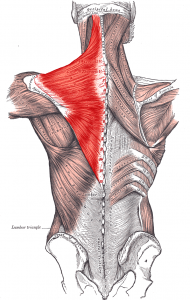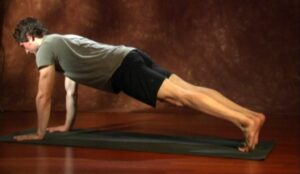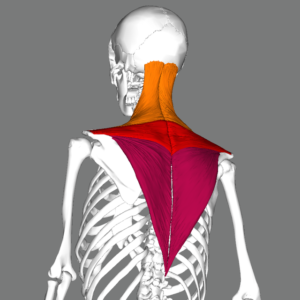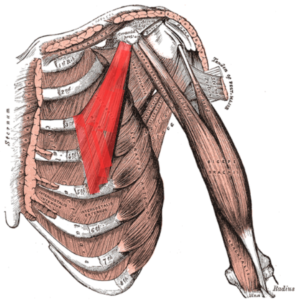 The trapezius muscle is a large diamond-shaped muscle of the upper back, then tends to carry a lot of tension at the top and not do much at the bottom.
The trapezius muscle is a large diamond-shaped muscle of the upper back, then tends to carry a lot of tension at the top and not do much at the bottom.
The trapezius muscle is usually separated into three sections—lower, middle, and upper—with different functions.
The upper trapezius muscle shrugs the shoulders and extends the neck.
The middle fibers retract the shoulder blades towards the spine.
The lower portion both draws the shoulder blade down and helps the upper fibers upwardly rotate the shoulder blade.
I often say that I teach diagnostically, starting classes with particular poses that allow me to see what is going in with the particular group of students in the room. Supta baddha konasana is one example.
If I have everyone lay flat on their backs with the knees bent and the soles of the feet together I can see what is happening with different students hips.
Another pose I use is plank, and lowering from plank to the floor.

Moving from downward dog to plank and then watching everyone lower down to the floor I can see a great deal about their core and shoulder muscles.
All too often I see both the upper and lower trapezius muscle suffer.
When someone lowers from plank to the floor not much should happen other than the arms bending as the rest of the body lowers to the ground. The trunk should lower as a solid section.
If you stand up with your arms outstretched directly in front of you with the wrists flexed, and bend the elbows to bring your hands alongside your chest you are going from plank to the floor without the weight bearing that goes along with being horizontal.
If you do this standing up it should be very easy to keep everything but the arms solid. Trying this from a plank is another story.
The difficulty is often a lack of good tone in the abdominal muscles so they don’t support the trapezius muscles which flail about unable to function properly.
Two things can happen to the trapezius muscle on the journey to the floor.

The shoulders often hike up towards the ears as the upper trapezius muscle overworks, and/or the head of the arm bone dives forward and down due to the inability of the lower trapezius muscle to counter the pull of the tight pectoralis minor.

I am sure it will be no big surprise to hear I think much of the trouble that people encounter with the trapezius muscle stems from a misalgined pelvis, low abdominal tone, and poor posture in general.
Misaligned bones, and muscles that lack the ability to stabilize the lower spine, lead to all sorts of trouble with the upper back, head and neck.
***
